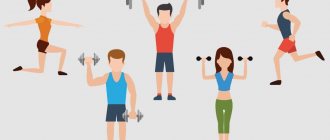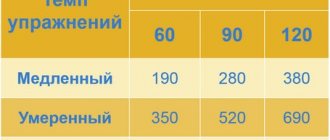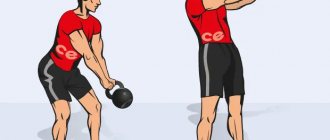Physical activity is one of the mandatory components to maintain good shape. But at the same time, it is important to know what loads and in what quantities burn calories. This is especially important for those who monitor their weight and are actively fighting extra pounds.
Below we suggest that you familiarize yourself with the description of physical activity, as well as their effective effect, i.e. the number of calories they help you get rid of over certain periods of time.
Walking
Walking is one of the types of gentle physical activity. It is used to warm up muscle mass before exercise or used as the main load. Here, a lot depends on the physical capabilities of the person, his physique and medical indications. In addition, walking is also divided into subtypes:
- traditional;
- sports;
- with loads, etc.
Calorie consumption depends on the initial weight of the athlete and the type of walking that he chose for exercise. One hour of traditional walking for a person weighing 50 kg will be 350 kcal; if the weight is 60-70 kg, then calorie consumption will increase to 500 kcal/hour.
How to burn more calories
We spend energy not only on intense movement. Calories are spent on heating the body, digesting food, growing hair and nails, beating the heart and inhaling air... Biochemical processes inside cells also require energy. Therefore, calories are constantly consumed, even while sleeping.
And yet, why do some people spend all their free time in the gym, but can’t lose weight, while others have never played sports and are still slim? A significant role in this is played by the so-called basal metabolism - an indicator of the intensity of energy metabolism. This is the amount of heat generated in the body in a state of complete physical and mental rest (lying down and at least 14 hours after eating) and thermal comfort (18–200C). On average, its value is 1 kcal/hour per 1 kg of body weight. At the same time, in women the basal metabolism is 5–10% lower than in men, and in people over 40 years old it is 10–15% lower than in young people. It also decreases with certain diseases (for example, hypothyroidism), as well as with fasting.
Cold to the rescue
| How quickly do your calories burn? How many calories will your body burn without any fitness, just through normal life? The consumption of kilocalories (kcal) for basal metabolism is calculated using the Harris–Benedict formula: For women = 655 + (9.6 x body weight in kg) + (1.8 x height in cm) – (4.7 x age in years). For men = 665 + (13.7 x body weight in kg) + (5 x height in cm) – (6.8 x age in years). Multiply the result obtained by the coefficient corresponding to your lifestyle: 1.4 – mental work, sedentary lifestyle; 1.6 – light physical work or active lifestyle (daily walks, fitness); 1.9 – moderate physical labor or active fitness classes, daily work around the house, in the country, etc. |
Surprisingly, our body spends maximum calories precisely on maintaining a constant body temperature, that same 36.60C. And this is in a normal, “room” climate. And, for example, when the air temperature drops by 10–150C, calorie consumption increases by 2–3 times! By the way, heating the body mainly uses energy from fat reserves - up to 90% (unlike physical exercise, which requires mainly carbohydrate expenditure). Therefore, in the autumn-winter season, the body intensively accumulates fat.
Experts recommend installing regulators on radiators and in the cold season making sure that the air temperature does not exceed +250C. Calories are spent especially actively in the cold - 10 minutes of walking can cost as much as 100 kcal! However, there is a risk: upon returning home, you crave hearty food - this is how the body wants to compensate for what was spent. You can “deceive” him with low-fat, but hot food - heated milk, light cream soup, coffee. Water procedures
In the summer, chilled food and drinks will come to the rescue - the body will have to spend calories to warm them up in the stomach. True, not much: to heat 1 glass of water (200 ml) by 10C, you need only 0.2 kcal. So 1.5 liters of water - the recommended minimum during the day when losing weight - from the refrigerator (i.e. about +100C) will help you consume 1.5 kcal. Water forces the body to burn calories not only from the inside, but also from the outside - even if you are just standing in it and not swimming. If you do not take into account equatorial latitudes, it is always colder than the body. For example, in a standard pool the water temperature is 26–270C, but since water is denser than air and has greater thermal conductivity, calories are burned more intensively. Therefore, after 30 minutes of even sluggish swimming, 200 kcal will be consumed. Simple moves
Nevertheless, movement still helps us lose weight. Even minor muscle contractions or their static work to maintain a certain position significantly increase energy expenditure. Let’s say a person spends 30 kcal per hour just sitting. And if you sit and knit, it’s already 100. Because your fingers move, your arms and shoulders tense, and it’s more difficult for your spine to maintain balance.
| Ways to increase Neat At work 1. Don’t ask anyone to go to another department to get documents, do it yourself. You'll burn calories, and at the same time, maybe learn something interesting. 20 kcal at a time. 2. Treat yourself more often: make a cup of coffee, clean up your desk. Minus 10–100 kcal for each action. 3. During your lunch break, be sure to go outside for at least 10 minutes. Minus 50-100 kcal. At home 1. Don’t shout anything to your children and husband in another room, but go there. 10–15 kcal at a time. 2. On the playground, do not sit on a bench, but walk around it. 40–50 kcal per hour. 3. Go with your family to the cinema, to attractions, to street shows and festivals - in general, to places where you can experience intense emotions. Up to 200 kcal for going out. |
In the West, they even came up with a special term NEAT - based on the initial letters of the English name Non-Exercise Activity Thermogenesis, which translates as “the formation of heat caused by activity not related to exercise.” Why "heat"? Yes, because energy from fat is, first of all, heat. Possible options
What everyday activities quietly help us lose weight?
Homework . Regular cleaning (brush dust off the TV and table, put unnecessary things in the closet, vacuum, load the washing machine, etc.) will take 150–250 kcal per hour. If you decide to do general cleaning with washing windows, chandeliers and moving furniture, count on at least 300 kcal per hour.
Shopping. Hypermarkets are especially useful for burning calories: wandering around them will deprive you of 200–250 kcal per hour. Children and pets. Playing with a cat, small dog or other small animal will burn up to 200 kcal per hour. An active walk in the fresh air with a child or a dog will take from 200 to 400 kcal per hour. If you don’t just play, but teach your child, for example, to play ball or ride a bike, then you can easily spend more than 400 kcal: intellectual stress and emotional experiences add 10–20%. It's the same with dog training. Even cleaning the aquarium “eats” about 100 kcal per hour. Garden plot. Fussing with flowers and ornamental plants consumes no less calories than planting traditional potatoes - 250–350 kcal per hour. At the same time, few people notice that a country house with a plot makes us walk more. As a rule, there is a greater distance from the bedroom to the kitchen, there are stairs, etc. With a book or laptop, you are tempted to sit not in your usual office, but in your favorite gazebo, which you also need to walk to. Even just walking along the path, you involuntarily turn towards a distant flowerbed: what has bloomed there? In general, even without doing anything special, outside the city you spend 150–200 kcal more per day.
Rest. According to experts, what type of recreation we choose depends on our genes: some are naturally active, while others are phlegmatic. The temperament we inherit genetically determines the level of NEAT. Alone on the beach, he won’t be able to lie quietly in a sun lounger and will either swim or dive, or build sand castles with the children, or run to the bar for water, and on an excursion he will poke his nose into every souvenir shop and carry around a massive camera. And another, who is not naturally inclined to fuss, will burn 150–200 kcal per day less. However, it turns out that it is not so difficult to increase your NEAT level: it is enough to be interested in what is happening around you more often. In the office. Here everything is even simpler: you need to get up more often. For example, get up twice an hour and stretch your legs by walking around the room or in the hallway for 2-3 minutes. By the way, doctors recommend such breaks to preserve vision, prevent diseases of the wrist joints (tunnel syndrome), spine and veins. 8-16 such rises during the working day - and 100-150 kcal are gone. Unexpected finds
Kissing and sex will require from 30 to 150 kcal per hour. Singing and/or playing a musical instrument will cost 50–100 kcal for 40 minutes. Talking on a mobile phone will take 15-20 kcal in 5 minutes if you get into the habit of walking while talking. Painting, embroidery, origami and other creative activities require an additional 50–100 kcal per hour. Violent emotions, for example, when watching a movie or sports broadcast, when reading a book or declaring love, are a rapid heartbeat, a rush of blood to the face, sometimes even tears in the eyes. All these are signs of increased metabolism. Emotional experiences increase it by 5–10%. This is why many people lose weight when they fall in love or, conversely, get divorced. Of course, positive emotions are better - against their background it is easier to maintain the achieved harmony, since there is no temptation to “seize” sad thoughts.
Author:
Tatyana Minina Published: February 27, 2016
Running and jumping
Running is a more challenging task for beginners. This activity trains endurance and breathing well. The load concentration is proportionally distributed throughout the body. With this type of physical activity, at a speed of 12 km/h, 600 kcal/hour is burned with a starting weight of 50 kg. A person weighing over 70 kg will lose about 1000 kcal in one hour of exercise.
The process will be more intense if you complicate the task and run, for example, up the steps - in this option, 13 kcal/hour will be burned per kg of weight. Jumping gives the same results.
How many calories are spent walking up stairs?
Walking up stairs uses more energy than running. When lifting at an average speed: men burn 0.17 kcal, and women 0.14 per kg of weight. In 30-60 minutes of walking up the stairs, you can burn from 500 to 1000 kcal. How many calories will be burned and how much fat will be burned is affected by: the speed of walking on the stairs and the angle of inclination of the stairs.
The higher the angle of inclination of the stairs, the more energy is consumed. However, performing the exercise on stairs with an inclination angle higher than 75 degrees is difficult and dangerous. Therefore, you should walk on stairs with an inclination of 65-75 degrees. Walking on stairs is not recommended for hypertensive patients, as well as people who have problems with blood pressure and the vestibular system.
Rock climbing
Traumatic, but intense type of exercise . It implies good concentration of the athlete and an even load on all muscle groups. It is recommended to start classes after a good warm-up of the muscles and joints.
For each hour of exercise, a little more than 12 kcal is burned per kg of weight. For example, under the same conditions, a girl weighing 50 kg will lose 615 kcal/hour, and a guy weighing 80 kg or more will lose 990 kcal.
Swimming
One of the most beneficial types of physical activity. Swimming helps keep all the muscles of the body toned. Has a beneficial effect on the spine and joints. This is one of the few types of activities that has the smallest list of contraindications.
In addition, this is a great way to lose weight and stay fit. The main load falls on the upper body: shoulders, biceps, triceps. Calorie consumption is 12 kcal/hour per kg of athlete’s weight.
Fitness
Standard fitness classes are the most popular today. Good fitness trainers make appointments several months in advance, because they will be able to correctly adjust the load to achieve the goal in the shortest possible time.
However, the calorie consumption table places fitness only in fourth place: according to its data, when doing fitness, a person loses a maximum of 11 kcal/hour for every kg of his weight. Those. a person weighing 50 kg loses about 550 kcal for every hour of exercise, and if the athlete weighs 80 kg, then the consumption increases to 880 kcal.
Losing weight with pull-ups
As for the first question, the answer here is obvious: “Yes, you can lose weight by doing pull-ups.” After all, during this exercise, muscles work, and any muscle work is accompanied by energy expenditure. However, there are some “BUTs”.
These “BUTs” include two main factors:
- Pulling up must be combined with rationalization of nutrition. That is, you need to follow a diet, since excess calories “invested” in fat will not be consumed if excess energy comes from outside (excess energy is energy that is in excess of basic needs).
- Pull-ups will only be effective if you perform the exercises “until you sweat.” And, unfortunately, not everyone is able to do this due to reduced physical fitness. Therefore, pulling up will help to effectively lose weight only for those who do not have large fat deposits.
Skis and bike
Skiing takes an honorable fifth place in the calorie burning standings - 9 kcal/h, which is 450 kcal/h for a 50 kg person, and 720 kcal for an 80 kg person. A similar situation is observed when riding a bicycle at a speed of 20 km/h. A decrease in intensity (speed) will lead to a loss of 6 (at a speed of 15 km/h) or 4 (at a driving speed of 9 km/h) kcal/h.
Skating, dancing, basketball, tennis, aerobics, football
These activities give approximately the same calorie burning results:
- skates burn 6.4 kcal/h;
- football – 8 kcal/hour;
- dancing and aerobics – 6.5 kcal/hour;
- tennis – 7 kcal/hour;
- basketball – 6.3 kcal/hour.
This allows a person with a body weight of 50 kg to get rid of 300-400 kcal, and a person with a body weight of 80 kg to get rid of 500-650.
Intimate activities
Sex can improve your mood, relieve physical stress, rejuvenate the body , and, of course, burn calories. It cannot be compared with running or walking in terms of the number of calories lost, but still, productive exercise in this type of physical and very pleasant activity will bring its owner a loss of 5 kcal/hour.
This time includes not only the most intense exercises, but also pre-preparation for the process, so experts recommend not to deny yourself a pleasant way to lose excess weight. For comparison, diving, rowing and bowling burn about the same amount of calories.
Home routines
Daily household chores also burn calories , like sports activities, but in smaller quantities. For example, a housewife loses 2-3 kcal/hour for every kg of her weight for every hour of housework.
That for a lady weighing 50 kg will be 100-150 kcal/hour, and for a lady with a slightly larger weight category (80 kg) - 160-240 kcal for every hour of her troubles. Household chores in this option include:
- cleaning;
- ironing;
- dressing/undressing (yourself or your baby);
- wash;
- washing dishes;
- walking down the street with a stroller;
- bathing the baby;
- garden cleaning;
- work in the garden;
- purchasing products;
- walking the dog, etc.
It should be noted here that the work of a massage therapist, trade workers, playing billiards and a host of similar activities burn approximately the same number of calories as in this case.
What is the calorie consumption for push-ups?
Push-ups are a great tool for building an athletic silhouette. Of course, it’s difficult to become a champion with push-ups alone, but it’s possible to slightly correct your figure. Also:
Read also: Mysteries of Space. Amazing facts
- This is an affordable and convenient way to strengthen your muscles and spend time benefiting your body and figure.
- The exercise is suitable for absolutely everyone, regardless of age and shape.
- When doing push-ups, the energy needed to perform the movement is lost.
Today there are many variations of the exercise, which differ significantly in energy consumption from each other. Each variation uses a certain amount of calories.
Under standard conditions and in the classic variation, 1 push-up takes 1 calorie. Body position – legs together, hands slightly wider than shoulders, back flat and straight. However, if these are not classic ones, then, accordingly, the energy costs will be completely different.
A computer and a scooter – what do they have in common?
Visually and by principle, these classes are located in directly diametrical planes. However, in the calorie consumption table, these are completely identical loads on the body, and therefore have the same performance indicators: 2 kcal/h, in other words, both the secretary and the scooter rider will spend 100 kcal in an hour of their classes with a weight of 50 kg, and if the weight is 80 kg - 160 kcal.
How many calories are spent during morning exercises?
Calculated energy consumption
| 5 minutes | 18 kcal |
| 20 minutes | 70 kcal |
| 30 minutes | 105 kcal |
| 45 minutes | 158 kcal |
| 1 hour | 210 kcal |
Interesting materials:
What to wear with brown shoes for a man? What's in a hamburger? What is in mushrooms? What is inside the Kazan Kremlin? What to write about yourself at an interview? What doesn't a cardiogram show? What is not visible on an ECG? What should you not give to your husband and wife? What should not be put in the dishwasher? What should you not eat with milk?
Rest
During the rest period, our body also burns calories , but at a very slow pace: quiet activities (knitting, watching TV, etc.) burn 0.5-08 calories per hour. Walking with your family, working in the office, singing, reading a book or newspaper out loud burns 1-1.5 kcal/hour.
For a person weighing 50 kg, this will be 25-40 kcal in the first option, and 50-75 in the second. This is a very weak indicator, especially if you take into account the indicators in terms of consumption/expense.
Recommendations for burning calories and distributing physical activity
- When starting any sport, you must start with a warm-up . Otherwise, injuries to tendons, joints, etc. are possible. To warm up, you can use walking, jumping (you can use a skipping rope), running, bending and turning the body, intense arm movements (sunshine, mill exercises), etc.
- The intensity of the loads must be clearly adjusted . During initial exercises, you need to gradually accustom the body to stress, for example, start with 15-20 minutes a day, gradually increasing the time of exercise by 5-10 minutes a day.
- Experts recommend not being fanatical about exercise ; the optimal daily load should not exceed 1.5-2 hours a day. It is permissible to distribute classes not every day, but with an interval of 1-2 days. This is enough to keep you in shape and burn enough calories to maintain your weight.
- Be sure to drink water . Remember - the normal dose of fluid per day for an ordinary person is 1.5 liters per day, subject to increased physical activity (sports activities) - at least 2 liters per day.
- Fasting will not bring results and will not help you lose weight. By going on a hunger strike, a person depletes the body, resulting in cellular starvation. Therefore, food is a necessary component for a healthy body and a strong body.
Calories for professional activities
The situation is a little more complicated with counting calories spent on various types of professional activities. For example, a person who builds a house is called a builder. But it’s one thing to lay bricks or do installation, and quite another to lead a team and work with drawings and documents. But both activities relate to construction.
Read also: Abdominal fold exercise
There are tables describing calorie expenditure for all kinds of activities. From them it becomes clear that the hardest time is for steelworkers and people who work with heavy hand tools. They spend 8.5 kcal per kilogram. It’s easiest for a bartender - 0.0439 kcal per kilogram (apparently, the nervous costs of communicating with not very adequate people are not taken into account).
The intensity of energy consumption depends on the chosen profession
Some idea of physical activity for various professions can be obtained from the following table (kilocalories per hour per kilogram of weight):
| a carpenter | 0,062 | truck driver | 2,1 | office worker | 1,24 |
| miner | 6,36 | police officer | 2,63 | clerk | 1,86 |
| builder | 5,82 | actor | 3,18 | working at the computer | 1,44 |
| firefighter | 12,66 | schoolboy/student | 1,86 | heavy equipment operator | 2,6 |
| forester | 8,54 | masseur | 4,2 | horse care | 6,4 |
| mason | 7,38 | coach | 4,2 | steelmaker | 8,5 |
What is the difference between the activities of a clerk and an office worker, why using a computer burns fewer calories than shuffling papers is very difficult to understand. Why a truck driver burns fewer calories than an actor or a police officer is unknown. Do not forget that the figures given here are very arbitrary; exact calculations are impossible and not necessary.










